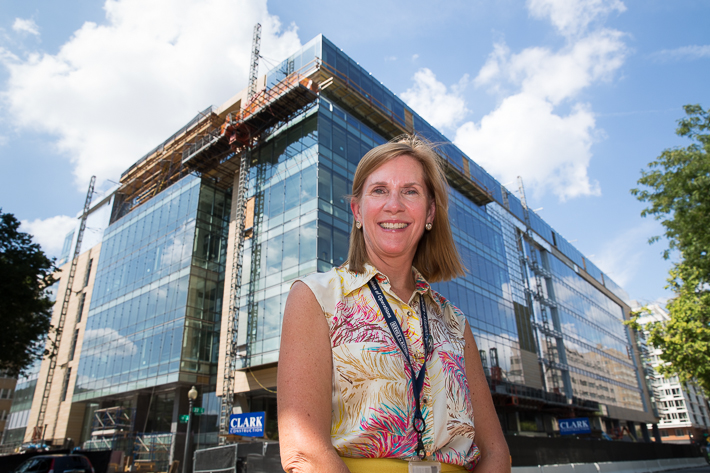With the fall semester in full swing, George Washington University students, faculty and staff have noticed a buzz of activity at the corner of 22nd and H streets Northwest as the Science and Engineering Hall—an eight-story modern research hub—nears completion.
GW researchers and faculty will move into the approximately 500,000-square-foot facility in December in advance of the building’s scheduled opening at the start of the spring 2015 semester.
Alex Weller, an 11-year Division of Operations staff member, will serve as building manager and facilitate the move-in process.
“In 2011, the university broke ground on a vision for an interdisciplinary research facility with state-of-the-art research space,” Senior Vice Provost for Academic Affairs and Planning Forrest Maltzman said. “This vision is months from becoming a reality. Science and Engineering Hall will inspire a new generation of faculty, researchers and students to explore their chosen fields of study, work together in ways they never could before and push the boundaries of innovation and discovery.”
Ms. Weller, who has been working with the SEH project team since its inception, will oversee day-to-day operations of the complex interdisciplinary space, which includes wet and dry laboratories, collaborative teaching areas, lounges and an aquatic suite.
SEH also includes a three-story high bay, an area with a strong wall and floor that is reinforced to handle the stress of large-scale experiments. Researchers will also make use of a nano-fabrication clean room for designing and manufacturing nano-scale devices, an imaging suite for producing high-resolution images and a greenhouse.
“Ms. Weller was selected by a team composed of academic affairs and GW operations staff members because she understands the building’s complex systems and is able to communicate with a variety of stakeholders,” Dr. Maltzman said.
She started her new role in May 2014, just five months after the SEH "topping out" ceremony.
“The design team met with researchers, faculty and staff during the design process to make sure that the facility meets their needs, and it is truly a collaborative environment,” Ms. Weller said. “I am excited to manage operations and become a part of what the university is doing academically through research.”

Newly named building manager Alex Weller, an 11-year George Washington University employee, will oversee the move-in process for the Science and Engineering Hall.
GW also announced this month that in addition to faculty and researchers in the School of Engineering and Applied Science and the Columbian College of Arts and Sciences, SEH will house some faculty and researchers from the School of Medicine and Health Sciences and the Milken Institute School of Public Health.
Some Milken Institute SPH and SMHS faculty and research staff will relocate to the seventh and eighth floors of SEH, respectively, following the completion of those floors in 2016.
Office and teaching spaces left vacant following the move—primarily in Bell, Tompkins and Corcoran halls—will be renovated over the through the course of a multi-year process.
“We are thrilled to be included in the Science and Engineering Hall, which will give Milken Institute SPH researchers world-class laboratory space and equipment, and the ability to push forward on a number of global public health problems,” said Michael and Lori Milken Dean of Public Health Lynn R. Goldman. “We look forward to working across disciplines to accelerate the search for improving the health of communities.”
SMHS Dean and Vice President for Health Affairs Jeffrey S. Akman said that the space also will benefit the university’s health and medicine research.
“SEH will enable more opportunities for research and discovery in health and medicine,” Dr. Akman said. “In the new space, the School of Medicine and Health Sciences will expand its research capabilities in the area of translational science, building bridges between the lab and the clinic to deliver novel therapies to patients.”
SEH was designed to encourage interdisciplinary partnerships, Ms. Weller said. To that end, departments and schools will be arranged in “research neighborhoods” that place laboratories and office space for different disciplines next to each other around a central, spiraling staircase.
The facility, which is lit naturally by an expanse of glass windows, will put research on display in glass-enclosed laboratories. It also features a multi-chamber clean room for researchers who need an isolated, sterile environment for developing, manufacturing and testing devices.
SEH also boasts a basement-level aquatic suite for the Department of Biology and an imaging suite.
Milken Institute SPH professor of epidemiology and biostatistics Jeanne Jordan—the first lab-based scientist recruited by Milken Institute SPH in 2008 – said that relocating to SEH is an opportunity to inspire collaboration among GW faculty and enhance academic opportunities for students.
“This facility will raise the visibility and awareness of research at the university and hopefully inspire students and researchers,” Dr. Jordan said. “I am excited to see faculty grow their programs to benefit students and enhance their own research.”


